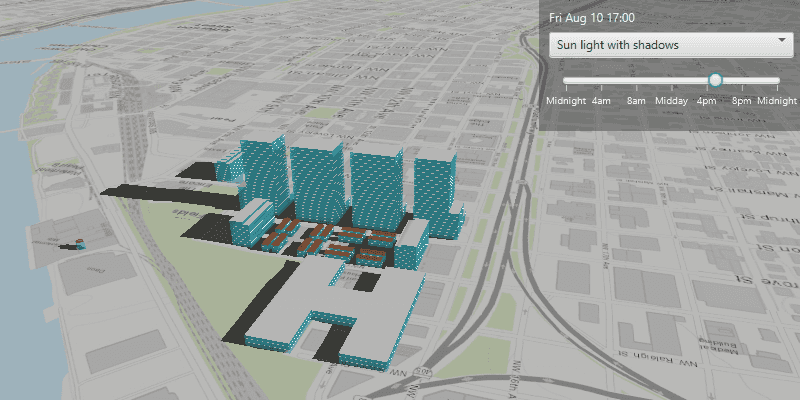Show realistic lighting and shadows for the time of day.

Use case
You can use realistic lighting to evaluate the shadow impact of buildings and utility infrastructure on the surrounding community. This could be useful for civil engineers and urban planners, or for events management assessing the impact of building shadows during an outdoor event.
How to use the sample
Select one of the three available lighting options to display that lighting effect. Adjust the slider to show the lighting effect for a particular time of day. The 3D buildings will display shadows when "Sun light with shadows" is selected.
How it works
- Create an
ArcGISSceneand display it in aSceneView. - Create a
Calendarto define the time of day. - Set the sun time to that calendar with
sceneView.setSunTime(calendar). - Set the
LightingModeof the scene view toNO_LIGHT,LIGHT, orLIGHT_AND_SHADOWSwithsceneView.setSunLighting(LightingMode).
Relevant API
- ArcGISScene
- LightingMode
- SceneView.setSunLighting
- SceneView.setSunTime
Tags
3D, lighting, realism, realistic, rendering, shadows, sun, time
Sample Code
/*
* Copyright 2020 Esri.
*
* Licensed under the Apache License, Version 2.0 (the "License"); you may not
* use this file except in compliance with the License. You may obtain a copy of
* the License at
*
* http://www.apache.org/licenses/LICENSE-2.0
*
* Unless required by applicable law or agreed to in writing, software
* distributed under the License is distributed on an "AS IS" BASIS, WITHOUT
* WARRANTIES OR CONDITIONS OF ANY KIND, either express or implied. See the
* License for the specific language governing permissions and limitations under
* the License.
*/
package com.esri.samples.realistic_lighting_and_shadows;
import java.text.SimpleDateFormat;
import java.util.Calendar;
import java.util.GregorianCalendar;
import java.util.TimeZone;
import javafx.fxml.FXML;
import javafx.scene.control.ComboBox;
import javafx.scene.control.Label;
import javafx.scene.control.ListCell;
import javafx.scene.control.Slider;
import com.esri.arcgisruntime.ArcGISRuntimeEnvironment;
import com.esri.arcgisruntime.layers.ArcGISSceneLayer;
import com.esri.arcgisruntime.mapping.ArcGISScene;
import com.esri.arcgisruntime.mapping.ArcGISTiledElevationSource;
import com.esri.arcgisruntime.mapping.BasemapStyle;
import com.esri.arcgisruntime.mapping.Surface;
import com.esri.arcgisruntime.mapping.view.AtmosphereEffect;
import com.esri.arcgisruntime.mapping.view.Camera;
import com.esri.arcgisruntime.mapping.view.LightingMode;
import com.esri.arcgisruntime.mapping.view.SceneView;
import javafx.util.StringConverter;
public class RealisticLightingAndShadowsController {
@FXML private SceneView sceneView;
@FXML private Label timeLabel;
@FXML private Slider timeSlider;
@FXML private ComboBox<LightingMode> comboBox;
private Calendar calendar;
private SimpleDateFormat dateFormat;
public void initialize() {
try {
// authentication with an API key or named user is required to access basemaps and other location services
String yourAPIKey = System.getProperty("apiKey");
ArcGISRuntimeEnvironment.setApiKey(yourAPIKey);
// create a scene with a basemap style
ArcGISScene scene = new ArcGISScene(BasemapStyle.ARCGIS_TOPOGRAPHIC);
// add the scene to the scene view
sceneView.setArcGISScene(scene);
// add a base surface with an elevation source to the scene
Surface surface = new Surface();
ArcGISTiledElevationSource elevationSource = new ArcGISTiledElevationSource("http://elevation3d.arcgis.com/arcgis/rest/services/WorldElevation3D/Terrain3D/ImageServer");
surface.getElevationSources().add(elevationSource);
scene.setBaseSurface(surface);
// add 3D building shells with a scene layer
ArcGISSceneLayer sceneLayer = new ArcGISSceneLayer("http://tiles.arcgis.com/tiles/P3ePLMYs2RVChkJx/arcgis/rest/services/DevA_BuildingShells/SceneServer/layers/0");
scene.getOperationalLayers().add(sceneLayer);
// add a camera and set the scene view's viewpoint to it
Camera camera = new Camera(45.54605153789073, -122.69033380511073, 941.0002111233771, 162.58544227544266, 60.0,0.0);
sceneView.setViewpointCamera(camera);
// set atmosphere effect to realistic
sceneView.setAtmosphereEffect(AtmosphereEffect.REALISTIC);
// set a calendar with a date and time
calendar = new GregorianCalendar(2018, Calendar.AUGUST, 10, 12, 0, 0);
calendar.setTimeZone(TimeZone.getTimeZone("PST"));
// set the sun time to the calendar
sceneView.setSunTime(calendar);
// format the string to just return the date and time (hours and minutes)
dateFormat = new SimpleDateFormat("EEE MMM dd HH:mm");
dateFormat.setTimeZone(TimeZone.getTimeZone("PST"));
String formattedDateAndTime = dateFormat.format(calendar.getTime());
// set a label to display the formatted date and time
timeLabel.setText(formattedDateAndTime);
// set the slider to display tick labels as time strings
timeSlider.setLabelFormatter(new SliderStringConverter());
// add the lighting modes to the combo box
comboBox.getItems().addAll(LightingMode.NO_LIGHT, LightingMode.LIGHT, LightingMode.LIGHT_AND_SHADOWS);
// show the name of the lighting modes in the combo box
comboBox.setConverter(new ComboBoxStringConverter());
comboBox.setCellFactory(comboBox -> new LightingModeListCell());
// update the sun lighting based on the lighting mode chosen from the combo box
comboBox.getSelectionModel().selectedItemProperty().addListener(e -> {
sceneView.setSunLighting(comboBox.getSelectionModel().getSelectedItem());
});
// launch the app with lighting mode set to NO_LIGHT
comboBox.getSelectionModel().select(0);
} catch (Exception e) {
// on any error, display the stack trace.
e.printStackTrace();
}
}
/**
* Set the sun time based on the time from the slider.
*/
@FXML
public void updateTimeOfDay() {
// when the slider changes, update the hour of the day based on the value of the slider
timeSlider.valueProperty().addListener((observable, oldValue, newValue) -> {
// get the value from the slider
int sliderValue = newValue.intValue();
// get the hour from the slider
int hours = sliderValue / 60;
// get the minutes from the slider
int minutes = sliderValue % 60;
// set the calendar with the hour and minute values from the slider
calendar.set(Calendar.MONTH, 7);
calendar.set(Calendar.DAY_OF_MONTH, 10);
calendar.set(Calendar.HOUR_OF_DAY, hours);
calendar.set(Calendar.MINUTE, minutes);
// format the string to just return the date and time (hours and minutes)
String formattedDateAndTime = dateFormat.format(calendar.getTime());
// update the label to reflect the current date and time
timeLabel.setText(formattedDateAndTime);
// set the sun time to the calendar
sceneView.setSunTime(calendar);
}
);
}
/**
* Converts the LightingMode values to strings to display in the open ComboBox.
*/
private class LightingModeListCell extends ListCell<LightingMode> {
@Override
protected void updateItem(LightingMode lightingMode, boolean empty) {
super.updateItem(lightingMode, empty);
if (lightingMode != null) {
if (lightingMode == LightingMode.LIGHT) setText("Light");
else if (lightingMode == LightingMode.LIGHT_AND_SHADOWS) setText("Light and shadows");
else if (lightingMode == LightingMode.NO_LIGHT) setText("No light");
}
}
}
/**
* Converts the LightingMode values to strings to display in the ComboBox.
*/
private class ComboBoxStringConverter extends StringConverter<LightingMode> {
@Override
public String toString(LightingMode lightingMode) {
if (lightingMode != null) {
if (lightingMode == LightingMode.LIGHT) return "Light";
else if (lightingMode == LightingMode.LIGHT_AND_SHADOWS) return "Light and shadows";
else if (lightingMode == LightingMode.NO_LIGHT) return "No light";
}
return "";
}
@Override
public LightingMode fromString(String string) {
return null;
}
}
/**
* Converts time values to strings to display on the slider.
*/
private class SliderStringConverter extends StringConverter<Double> {
@Override
public String toString(Double hour) {
if (hour == 240) return "4am";
if (hour == 480) return "8am";
if (hour == 720) return "Midday";
if (hour == 960) return "4pm";
if (hour == 1200) return "8pm";
return "Midnight";
}
@Override
public Double fromString(String string) {
return null;
}
}
/**
* Disposes of application resources.
*/
void terminate() {
if (sceneView != null) {
sceneView.dispose();
}
}
}